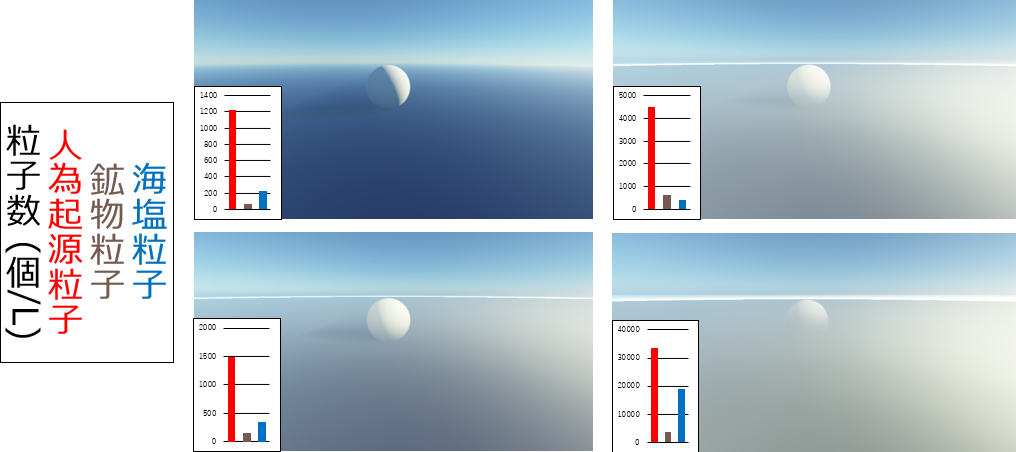Summary
Particles such as yellow sand and PM2.5, which cause air pollution—a major global problem—are called atmospheric aerosols. These substances not only affect human health but also significantly impact visibility and the color of the atmosphere. In the real world, visibility is a crucial indicator in transportation sectors, including aviation. In Japan, the Japan Meteorological Agency conducted visual visibility measurements until 2019. Although automated measurements were introduced thereafter, challenges with model accuracy mean they are not always highly reliable. Therefore, reproducing visibility changes using CG holds significant importance. Furthermore, the color of the atmosphere appears different depending on the pollutants present: when yellow sand is abundant, the atmosphere appears yellowish, and when PM2.5 is abundant, it appears grayish.
The distribution of atmospheric aerosols is measured using a Polarization Optical Particle Counter (POPC). The POPC measures particle size, particle number, and the polarization characteristics of particles. Based on particle size and polarization characteristics, it classifies particles into three types: anthropogenic particles, mineral particles, and sea salt particles.
In this study, we attempt to reproduce distant-scene radiation profiles that vary with particle size distribution by calculating the dissipation coefficient—the proportion of light scattered or absorbed by atmospheric aerosols in the air—from the particle composition and number concentrations measured by the POPC.

The results of rendering distant scenes
based on four types of particle composition distributions are shown.
It can be confirmed that the appearance differs depending on the particle composition distribution.
Members
| Name | Affiliation | Web site |
|---|---|---|
| Keio University | ||
| Soma Yokota | University of Tsukuba | |
| Hiroshi Kobayashi | University of Yamanashi |
Publications
Presentation
Unrefereed
- Homare Onuki, Hiroshi Kobayashi, Soma Yokota, Issei Fujishiro: “Reproduction of visibility changes based on atmospheric distributions,” in Proceedings of the 87th National Convention of International Processing Society of Japan, Vol. 2, pp. 473―474 (5S-01), The University of Ritsumeikan, March 14, 2025.
- Homare Onuki, Soma Yokota, Hiroshi Kobayashi, Soma Yokota, Issei Fujishiro: “Reproduction of Distant View Based on Particle Size Distributions of Atmospheric Aerosols,” in Proceedings of SIG Technical Reports, Vol. 2025–CG–199, No. 9, pp. 1-6, Waseda University, September 9, 2025(in Japanese), Best presentation award (in Japanese).
Grants
 Grant-in-Aid for Scientific Research (A): 21H04916 (2021-)
Grant-in-Aid for Scientific Research (A): 21H04916 (2021-)